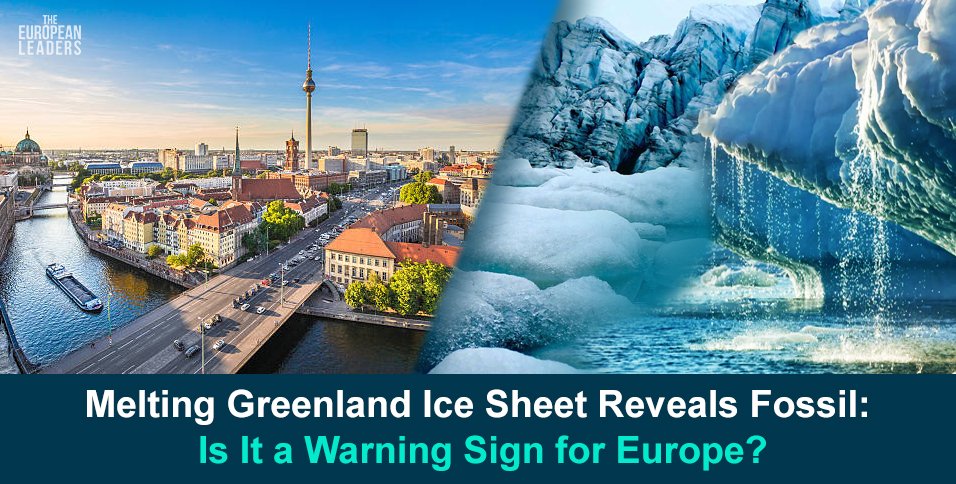The European Leaders
7 August 2024
Nuuk – Recent discoveries in Greenland have unveiled alarming evidence about the fragility of the Greenland ice sheet, with profound implications for Europe’s future.
A team of scientists has found ancient plant and insect fossils beneath two miles of ice, confirming that the center of the ice sheet melted during a warm period in the past, suggesting that Greenland was once home to a vibrant tundra ecosystem.
This melting research, published in the Proceedings of the National Academy of Sciences, highlights the potential for significant sea-level rise, which poses a direct threat to coastal cities across Europe.
The fossils, including willow wood, insect parts, and poppy seeds, indicate that the ice sheet has melted more extensively than previously understood.
Paul Bierman, a co-author of the study, emphasized that if the center of the ice sheet melted, it is likely that much of the surrounding ice also disappear, potentially leading to a sea-level rise of 23 feet (7 meters) over the coming centuries if greenhouse gas emissions continue unchecked.
Economic Impact of Greenland Ice Sheet Melt
The Greenland ice sheet is losing ice at an unprecedented rate, contributing to rising sea levels that could cost Europe up to €872 billion (approximately $950 billion) by the year 2100.
Coastal regions, particularly low-lying areas like Veneto in Italy, may experience devastating economic losses, with projections indicating a GDP decrease of over 20%. The economic fallout will not be evenly distributed, with sectors such as agriculture, logistics, and public services being more vulnerable to the impacts of climate change.
Geographic Vulnerabilities
Europe’s extensive coastlines make it particularly susceptible to the ramifications of rising sea levels. Projections suggest that global sea levels could rise by as much as 1.77 meters by 2100 under high emissions scenarios. This poses a direct threat to coastal cities and infrastructure, increasing the risk of permanent inundation in low-lying areas.
As the ice sheet melts, it contributes to rising sea levels, which are currently increasing at a rate of more than an inch per decade. Major European cities like London, Amsterdam, and Venice are particularly vulnerable to flooding and coastal erosion.
The economic implications are staggering, with potential damages to infrastructure and property valued in the hundreds of billions of euros.
Moreover, the melting of the Greenland ice sheet is linked to extreme weather patterns across Europe. Studies have shown that the ten hottest and driest summers in the past 40 years have followed significant releases of freshwater from Greenland, which disrupts the atmospheric jet stream. This disruption can lead to prolonged heatwaves and droughts, particularly in southern Europe, exacerbating existing climate challenges.
The findings from Greenland serve as a stark warning about the fragility of the ice sheet and the urgent need for global action on climate change. As scientists continue to study the implications of these discoveries, the message is clear: without significant reductions in greenhouse gas emissions, Europe faces an uncertain future marked by rising seas and extreme weather events. The time to act is now before the consequences become irreversible.
Contributions to Global Sea Level Rise
The Greenland ice sheet currently contributes approximately 234 billion tons of ice loss each year, accelerating seven times faster than in the 1990s. This ongoing melt is forecasted to add an additional 1-2 meters to global sea levels, with dire consequences for densely populated coastal cities across Europe.
Implications for Coastal Management Strategies
As rising sea levels threaten coastal regions, there is an urgent need for improved coastal management strategies in Europe. Investing in protective measures, such as barriers and sustainable urban planning, is crucial to mitigate the risks posed by climate change.
Without proactive adaptations, many coastal cities may face devastating economic and environmental consequences.
Changes in Ocean Currents Affecting Climate
The melting ice also alters ocean currents, particularly the Atlantic Meridional Overturning Circulation (AMOC), which regulates climate across Europe.
A slowdown in this critical circulation could lead to colder temperatures and more extreme weather patterns, exacerbating the challenges European countries face in managing climate impacts and maintaining economic stability.
End Note on Melting Greenland Ice Sheet
The findings from Greenland serve as a stark reminder of the interconnectedness of climate systems and the urgent need for action.
Europe must invest in adaptation strategies and reduce greenhouse gas emissions to combat the impending threats posed by the melting Greenland ice sheet. The clock is ticking, and the time to act is now to protect both the environment and the economy.








